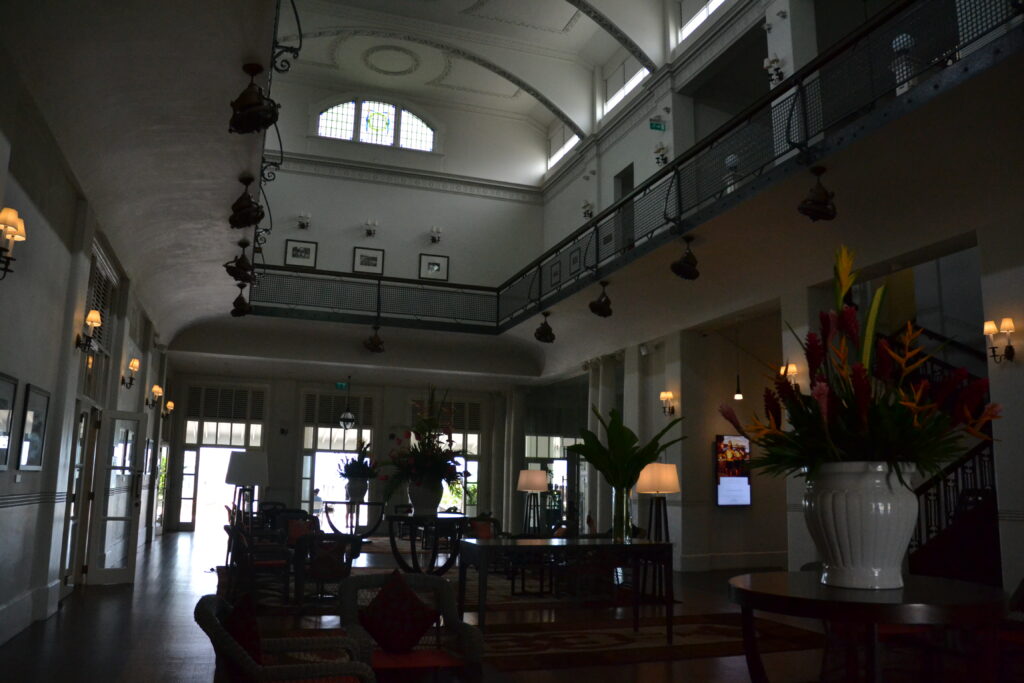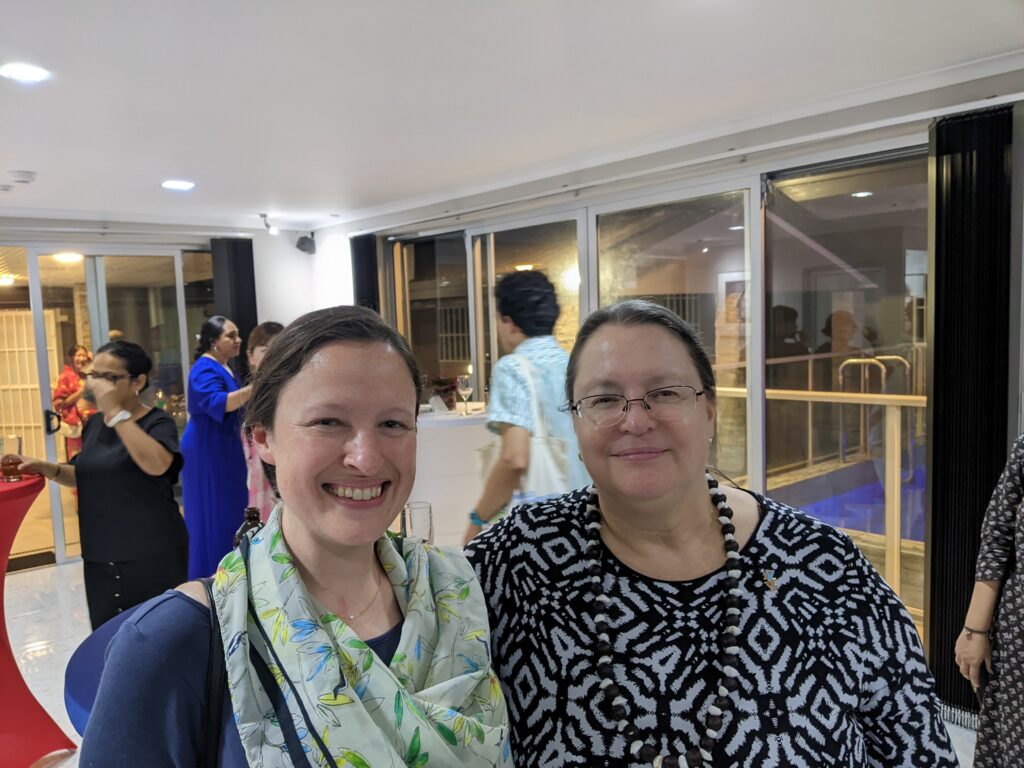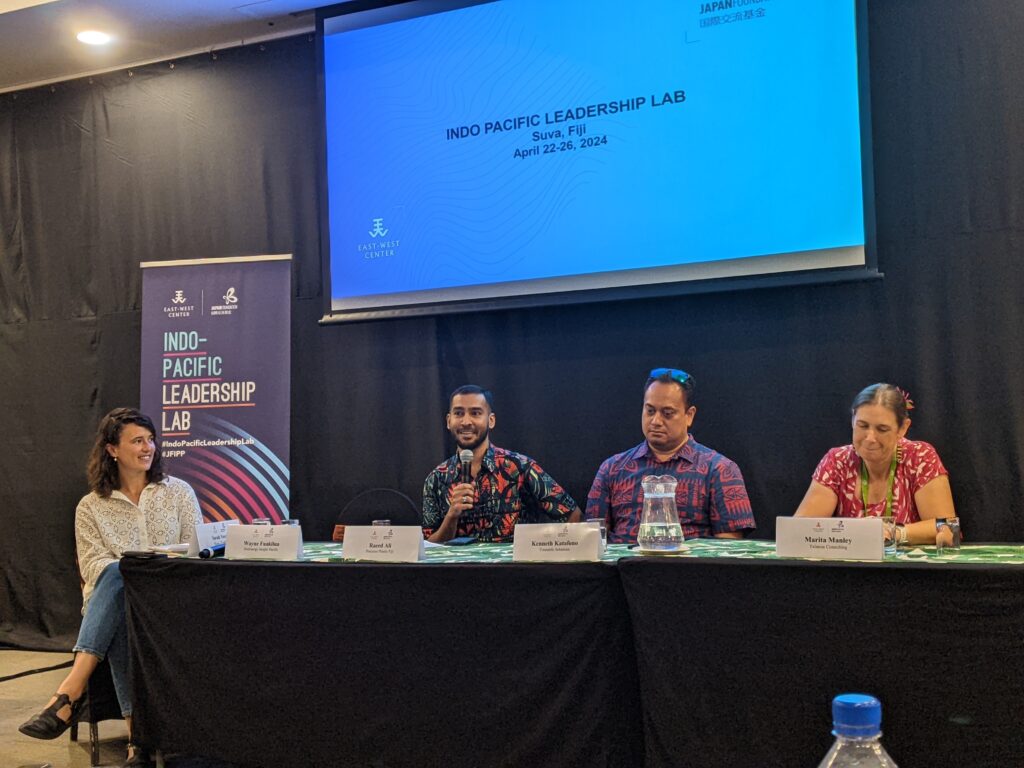<– Start at the beginning of the Climate Lab series
Fiji, Part 1 – In the Classroom
The first few months of 2024 were a blur, and although it felt like we had just seen each other in Hawai’i for the first in-person session of my climate adaptation leadership lab, the end of April brought with it our second session in Fiji. For as embarrassingly little as I knew about Hawai’i before this program, I knew even less about Fiji. Fortunately we were assigned extensive reading and research assignments related to Fijian culture and history, climate change vulnerabilities, and policy approaches ahead of time, but – as is always the case with working on the ground – nothing ever really prepares you for being there and seeing it yourself.
History of Extraction
I would venture a guess that most Americans don’t know much about Fiji beyond the water brand. When I was in grad school, we did a case study on Fiji Water, and I gained a little more perspective into the exploitative and extractive practices that happen throughout the world (largely in developing countries) in order to support our way of life here in the United States and in other developed nations. And, unfortunately, that concept is not new. Fiji, which was settled by Pacific seafarers around 1500-1000 BC and inhabited by Melanesian people for almost two millennia, was annexed by the British in 1874, who then expanded efforts to bring indentured laborers from India to work on the sugarcane plantations. (Fiji won its independence in 1970.)

The history of settlement, colonization, and political struggles in Fiji is incredibly detailed, [1] but for the purposes of laying the groundwork for our visit, we just got the highlights: the impacts of colonialism, extraction of natural resources, and racial tensions that resulted from bringing in large numbers of Indian laborers. At present day, Fiji has just under one million inhabitants, living on 100 of its 300-plus islands. Indigenous Fijians make up over 50% of the population, with Indo-Fijians (largely descended from indentured workers) making up less than 40%, and a mix of other nationalities rounding out the difference.
For a country with a population smaller than that of Hawai’i, Fiji plays a critical role in the region, being centrally located and having one of the most developed economies among the Pacific islands, but with almost a third of their residents living below the poverty line. [2] Its leading economic sector is tourism, which we were told makes up 40% of Fiji’s economy, with industry (mining and manufacturing) and agriculture (sugarcane) making up – approximately – an additional 20% and 10%, respectively. Similar to Hawaii, tourism represents a double-edged sword, providing a valuable influx of tourist dollars, while also exacerbating one of the biggest issues facing Fiji and other island nations throughout the Pacific: climate change.
Mitigation and Adaptation
Once again, it felt ironic to be flying across the Pacific (and drastically increasing my carbon footprint) as part of a program for which I am supposed to be developing approaches to combat climate change. However, the lessons we learned on the ground were extremely valuable – lessons I don’t believe we could have learned as fully in a virtual classroom. We did still start the week in a literal classroom, where we heard from members of government and the private sector alike about the risks of rising sea levels and more severe storms making life in coastal villages increasingly more difficult. There is an intrinsic relationship between pollution mitigation and climate adaptation: the more we do of the former, the less we’ll have to do of the latter. But unfortunately (at least at this point) there isn’t always a direct relationship between how much you pollute and how much you feel the impacts, making many of us with big carbon footprints unaware of the impacts we’re having in other places around the world.

Although Fiji is a small contributor to global emissions (and therefore climate change), the country has decided that it wants to lead by example and has set forth an ambitious National Adaptation Plan (which also includes mitigation activities) [3] as part of the United Nations Framework Convention on Climate Change. [4] Fiji’s mitigation sectors include electricity generation and transmission (renewable energy, distributed microgrids, and battery storage), demand-side energy efficiency (improved standards for buildings and appliances), and transportation (upgrades for roads, electric vehicles, and marine protections in coastal areas.) But since they are also seeing disproportionate impacts from climate change, adaptation is necessary as well. Adaptation sectors include food and nutrition security, access to healthcare, climate-resilient infrastructure, maintaining biodiversity in the ecosystem, and addressing the needs of human settlements.
In our pre-travel research, our cohort dove into the weeds of the National Adaptation Plan, the Nationally Determined Contribution [5] (their self-determined emissions reduction goal set under the Paris Agreement [6]), and the Low-Emission Development Strategy, [7] among others, which appear to have some overlap with each other, though they are not identical. We also learned what an absolute alphabet soup of government ministries, departments, regulators, compliance and enforcement agencies, and service providers are involved in each individual effort.
Putting Plans Into Action
The level of bureaucracy I had to navigate in my research was enough to make me feel like I was completely out of my league, utterly lost, and in no way deserving of being a member of this cohort. And then, at our next class, I learned the assignment was meant to be frustrating. As our guest speaker from Fiji said to us, “if you think you were frustrated researching it, just imagine what it’s like for people living here.” We learned there is a real risk that by putting so much time and money into creating these comprehensive plans – and not coordinating with complementary efforts – that very little of the money and benefit actually trickles down to the communities that are supposed to be helped by them. Of course, that problem isn’t unique to Fiji, and, in all reality, it’s not unique to government either, which is why it was a significant focus for us in the conversations we had both in the classroom and in the field.

Our guest speakers and panelists helped us prepare for what we were about to see at the beginning of the week and then contextualize what we saw at the end of the week, and what we saw was inherently paradoxical. We heard calls to get involved, to be an agent of change, and to encourage individual action, but we also heard that the existential threat of climate change can’t be solved with individual action. We heard about comprehensive government efforts to help people that ultimately didn’t result in people feeling helped. We heard about Fiji’s tourism industry bolstering their economy, but also putting Fiji’s wellbeing at greater risk if left unchecked. As I mentioned above, part of this program is for us to develop solutions of our own, but it was looking increasingly difficult.
When it came to identifying problems and brainstorming solutions, we heard a lot about identifying opportunities for better communication, which makes perfect sense. It’s important to remember that silos don’t just happen within an individual organization or within a government structure – though those can be significant. Some silos that are so big that they make it difficult to see across sectors, automatically separating unlikely partners who might have common goals. For example, “business” can be a dirty word, since so much business has contributed to pollution in the name of profit over the years, but from the business leaders we met that week, we heard a love of the environment and a desire to make a positive difference. To quote one panelist: “profit isn’t the goal – impact is the goal.” (I know that perspective is why I got an MBA in Sustainable Business Practices.)
As we prepared to depart from Fiji’s capital of Suva to visit several villages, we were encouraged to keep a few things in mind – things that I certainly understood intellectually and in the context of my own work but maybe didn’t yet fully “grok,” in Heinlein’s parlance. [8] Some of those things included keeping a check on our own cultural perspectives and biases, noting whether people or agencies were being held accountable to their commitments, and whether there were people who weren’t represented at the table. And that last piece regarding inclusive engagement would turn out to be a difficult hurdle when we encountered cultural norms that were drastically different from the ones I was used to back at home.

That’s where we’ll pick up next week. Have you been to Fiji or do you have specific questions about our trip there? I’d love to hear them in the comments below.
Thanks for reading!
The Indo-Pacific Leadership Lab [9] is a program of the East-West Center,[10] with support from the Japan Foundation.[11]
As always, content on this blog reflects my personal views, and not those of any organization with which I am associated.
[1] https://en.wikipedia.org/wiki/History_of_Fiji
[2] https://www.economy.com/fiji/indicators
[3] https://www4.unfccc.int/sites/NAPC/Documents/Parties/National%20Adaptation%20Plan_Fiji.pdf
[4] https://unfccc.int/topics/adaptation-and-resilience/workstreams/national-adaptation-plans
[6] https://unfccc.int/process-and-meetings/the-paris-agreement/nationally-determined-contributions-ndcs
[8] https://www.merriam-webster.com/dictionary/grok
[9] https://www.eastwestcenter.org/projects/indo-pacific-leadership-lab
[10] https://www.eastwestcenter.org/
1 Comment
rjwarren59c8cb9109c0 · August 19, 2024 at 2:28 pm
Great piece of research. I can’t imagine living in Fiji after being so spoiled here in the U.S.A.
It saddens my heart so many Islands and countries suffer in so many levels. A, do you think things will ever change for the greater good of man kind and our Earth?
A.B.